by Rick Landers.
 |
| Randy Jennings. Photo by Jennifer Jennings/2-artists.com. |
Modern Guitars caught up with photographer Randy Jennings a while back to check out his inventory of rock and other live-music photography. His body of work includes photos of major rock guitarists that have grippped our imaginations over the years. His Captured Live Photography website gallery attests to his ability to click at the right moment to get the shot.
Jennings’ work can be found in Rolling Stone, Hal Leonard Corporation publications, Guitar Player, Hot Licks Productions, VH-1 Music Television, Goldmine, Genesis, Alligator Records, and Taylor Publishing. His photos have been featured on several TV stations’ music features, high fashion clips, sport news and other hot spot assignments where dynamic photos are essential to tell the story.
Randy’s artistry can be found in books like Keri Leigh’s Stevie Ray – Soul to Soul, and Craig Hopkins’, outstanding biography,The Essential Stevie Ray Vaughan. He’s also a Strat player and given his SRV inventory of shots, we expect he’s a fan of the Texas guitar slinger. His photo “fix” offered him opportunities to get close to a slug of hot guitarists and other musicians including: Albert Collins, Eric Clapton, The Allman Brothers Band, Led Zeppelin, the Who, Warren Zevon, Gregg Allman, Lonnie Mack, Rod Stewart, Albert King and other icons of music.
Randy’s wife, Jennifer, is a fellow artist who’s focus on painting complements his desire to document life in portraits, natural settings and live action. Their shared artistic journey and love of nature often find them trampling in the hills of Tennesse with their two sons, followed by their three dogs.
In his Modern Guitars interview, Jennings discusses photography techniques, the challenges of live photography, celebrity guitarists and other performers he’s covered during the past few decades.
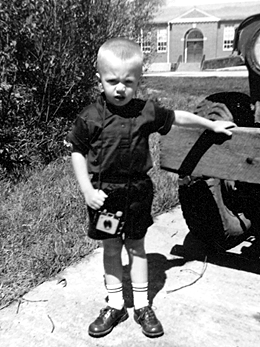 |
| Randy Jennings, 1961. Photo courtesy of Mama J. |
Rick Landers: When did you first get bitten by the photo bug?
Randy Jennings: I believe it was around the 1971 or ’72. I was taking a class in high school and had this a little Instamatic camera. One where you get a roll of black and white film. I’d get some nice shots of the mountains in Tennessee. Or when I was down visiting relatives with my uncle’s bird dog when I saw a bear and thought “Oh, this is cool!” I really enjoyed that and kind of tinkered a little bit from that point on. That’s where it all began, as far as just the camera in general.
Rick: You’re from Tennessee?
Randy: Yeah. What’s ironic is I have a photograph of my mom and me when I was around three years old, standing beside this old Willy’s Jeep. I’ve got a camera around my neck, which is kind of weird.
Rick: Most photographers have moved from the dark room ages to digital; are you an all digital guy now or do you move between the two skill sets?
Randy: Actually, I’m still a film guy. I own no digital cameras at this time. I’m probably going to start moving in that direction. I still think of photography as more of an art, not that digital isn’t art.
My passion is black and white. I don’t think you get the true tonality with digital black and white, as you do with film. Sometimes, post-production, I’ll have my negatives scanned digitally.
Rick: So, after you’re done working in the dark room and developing, then you’ll scan them?
Randy: Yeah. I still love dark room work! It’s just that a lot of the time, it’s not effective when you have a bunch of stuff to do and don’t have it set up all the time. I don’t have a dark room I can just walk in. I have to go through a production just to set up or tear down. Sometimes it’s easier just to scan the black and white negatives and then I will take it to a lab. It’s still not a digital print. But, it will be a wet process photograph still.
Rick: And then it’s eventually converted to digital in order to put it on the web?
Randy: Yeah, for website work or magazines like Modern Guitars.
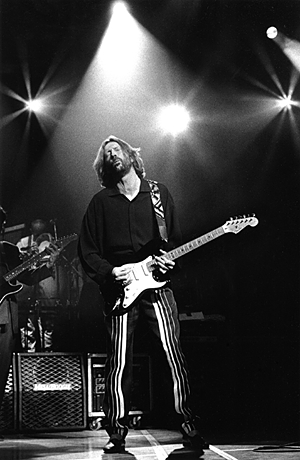 |
| Eric Clapton, 1990. Photo by Randy Jennings. |
Rick: Tell us about the first music gig that you went to with a camera.
Randy: It was March 2, 1975 with Johnny Winter, James Cotton, and the James Gang. I was a big Johnny Winter fan. I’m still a big Johnny Winter fan! I had an Ashika TL Electro and three rolls of Ectachrome, one roll of triex, and an Acura lens.
It was great! I was a senior in high school and I got to see James Cotton, then the James Gang. Johnny Winter was the anticipation and my heart was pounding. I was 17 years old. It was like, “Wow! This is Johnny Winter!” and I thought, “This is great!”
I’ve pulled them out in the last year or so and have been thinking about doing a book. I definitely want to include the first concert I ever shot. I can’t remember what I had for dinner tonight. But, I can remember March 2, 1975 at that arena in Dayton, Ohio.
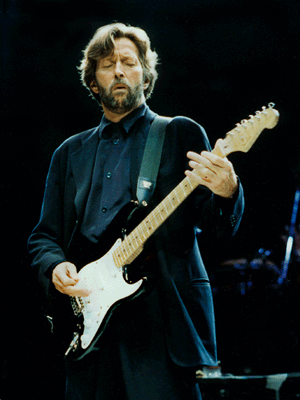 |
| Eric Clapton, 1990. Photo by Randy Jennings. |
Rick: I remember the James Gang when they first came out. They mad some great music.
Randy: Yeah. My seventh grade science teacher was the first bass player for the James Gang back in his college days, before Dale Peters.
Rick: Oh yeah?
Randy: I want to say he was at Kent State. But, it’s been many years. He had all of these pictures of himself with Joe Walsh and Jimmy Fox, and backstage shots. Without them, he thought, nobody would have believed him!
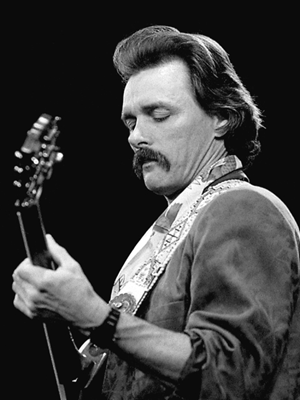 |
| Dickey Betts, 1986. Photo by Randy Jennings. |
Rick: When did you start defining yourself as a professional career photographer rather than a hobbyist?
Randy: [Laughs] Still wondering where it crossed the line! It’s very competitive. And with digital photography these days, a lot of people don’t want to hire anybody. As a matter of fact, I’ve got to talk to somebody tonight about a gig. I don’t know, I started making money with photography shortly after high school. I hated the thought of doing weddings and things like that. I wanted to photograph rock and roll.
Once I did the Johnny Winter show, that was it. It combines two of my loves, music and photography. I’ve done different types of photography for the money. I had a studio for a while and was doing corporate stuff like head shots, aerial, commercial and medical photography. Things like that. But, today’s market is very competitive. Everybody tries to do it in-house, mostly because they don’t want to pay for it. You know, it’s like, “I’ve got a camera, I can take this picture.” I compare it to, “I have a knife and my appendix needs to come out. But, I’m not a doctor.”
You’re not really paying for the camera, you’re paying for that expertise or that vision, that eye. I’m not saying that there aren’t very talented people out there. In fact, I’m surprised on a daily basis when I’m on the Internet and see the quality of the vision. I don’t know if it’s the quality of the people or if it’s just the simplicity of the cameras these days. Or, if there’s a lot of good eye coming along. There probably’s that too.
My wife is an artist and so we see a lot of photography and a lot of art. She teaches art and we see a lot of museum exhibits. Look around, there’s a whole lot of talented people out there. Any kind of artistic endeavor is very competitive these days.
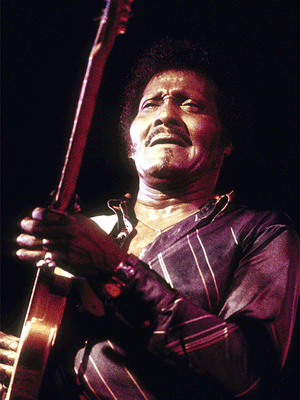 |
| Albert Collins, 1986. Photo by Randy Jennings. |
Rick: What camera equipment do you carry for everyday purposes, and do you have special equipment for unique jobs or opportunities that come along?
Randy: The majority of my stuff is 35mm. All are older Nikons, no auto focus and nothing programmable. I have two F2s and an F3; I have a Hassleblatt format. It depends on the output size. Then, I have a little Olympus point and shoot that’s 25 or 30 years old.
I also like to screw around with these cameras called Holgas. They’re these little plastic cameras and kind of “Saturday Night Specials,” and you don’t know if they’re ever going to work! The backs fall off. They have light leaks. They’re more of a creative artistic thing and just kind of fun to mess around with.
Occasionally, I’ll take a Holga to a show and shoot and see if I get something. It’s kind of cool and more of an artsy thing to do. You get a couple of bucks for a roll of medium format film. Then you put about three dollars worth of black masking tape on it to keep the light leaks out or to keep the back from falling off. It’s entertaining.
Rick: How about the old Polaroids?
Randy: I like the old Polaroid Big Shot. I don’t know how old you are or how long you’ve been around. But, Polaroid made these really long cameras that just take head shots. I’ve messed around with those. I’m kind of an Andy Warhol fan and I have several of those. You can buy them on eBay used for about fifteen bucks. Before they die, you might get a couple of shots off of them. After they’ve been sitting around, they usually don’t last for very long.
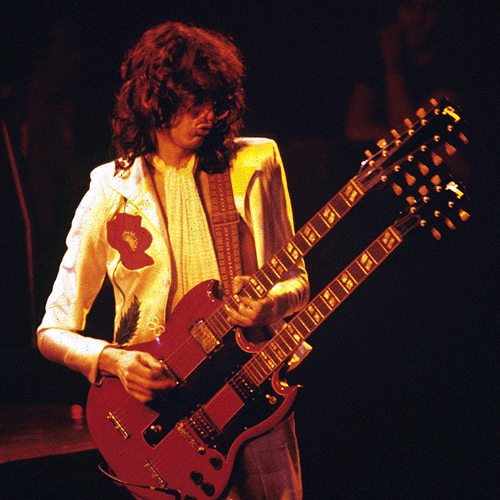 |
| Jimmy Page. Photo by Randy Jennings. |
Rick: What’s the toughest music environment to get a good shot?
Randy: Probably shooting live. Well, no doubt about that, especially when there’s no photographer pit that keeps you separated from the crowd. That’s how it was when I first started out. You had to get there early and get up close and try to avoid the risk. I’ve been set on fire! I’ve been hit with drum sticks and gotten cut.
I was set on fire at a ZZ Top concert! Some guy said, “Dude! You’re on fire!” I looked down and my coat was on fire. Somebody had flipped a cigarette and I had my jacket tied around my waist. The thing got caught in my pocket! Then there was a drummer that was throwing drum sticks at me. He didn’t want me taking his picture!
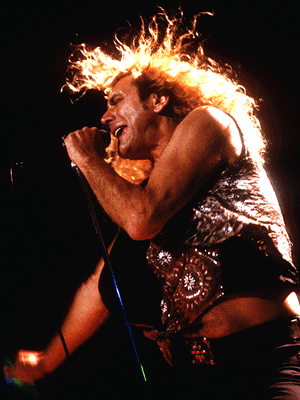 |
| Robert Plant. Photo by Randy Jennings. |
Rick: What year was that?
Randy: The fire or the drum stick?
Rick: The drum stick.
Randy: I think that was around ’86.
Rick: And that was ZZ Top?
Randy: No ZZ Top was ’77. I’d rather not mention the band with the drummer. They were kind of “has beens.” This bar where they were playing was for those up and coming bands or for people on the way down. They were on the way down.
Rick: Are you a musician?,
Randy: I play enough guitar to be asked to stop or to be invited offstage! I recently purchased a 2006 American Stratocaster, kind of a big investment. I like to hack around with it. For the most part I’ve always had one lying around. I had a ’68 Gibson Hummingbird. I really wish I still had it. It was either at a point in my life where I thought, “I can make money off my guitar or my camera.” I guess I figured the guitar had to go.
Rick: We’ve all had guitars we wish we still had.
Randy: Oh yeah, that was my favorite. It was a beautiful guitar. I still have a nice picture of it.
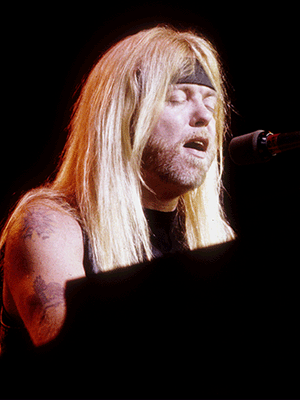 |
| Gregg Allman, 1987. Photo by Randy Jennings. |
Rick: Do you find any advantage being a musician in your photography?
Randy: Oh yeah, definitely. If you’re familiar with the musician and his song, you know about what’s going to happen next, at least somewhat. I mean, you know he’s going to have to bend the string and you know it’s a good time to get a good shot.
I don’t see the show well during the first three songs. But,I can look back and know what teh guitarist was doing. I remember the emotion that was going on at the time. With me it’s more than just taking pictures. It’s a feeling, an emotion. I can remember a a Lonnie Mack show and my being in a rough spot in a relationship. He had a song called “Tough on Me, Tough on You.” I was like, “Wow!” I remember that part of the show and it did help being familiar with the guitar and to understand what he was doing.
Rick: When you’re working a gig do you think you miss some of the fun at the concert? It sounds like, although there’s a mechanical part of being a photographer, that you’re still kind of immersed in the sound and the music?
Randy: Well, a lot of it you do kind of miss. You’re out there and you’re limited to the first three songs and you’re thinking, “I gotta get my shot, I gotta get my shot.”
If it’s a club environment where you have access to shoot the whole thing, then yeah, you can enjoy the show a bit. But, for the times when you only have those first three songs to shoot, I just want to make sure I get something first.
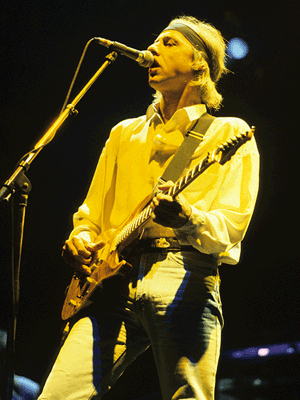 |
| Mark Knopfler, 1992. Photo by Randy Jennings. |
Rick: Do you scope out the place beforehand and figure out where you can get some good shots?
Randy: Most of the places I’ve shot. Sometimes, if I haven’t already been there, like if it’s out of State or someplace new, I try to see it prior to the shoot. Sometimes you get in and deal with what’s thrown at you. I detest flash. It just steals the feeling to me. I also hate it when a club has lights and doesn’t use them adequately. There’s place where I used to hate shooting, because they used to put a red flood light and a blue flood light in two Folgers coffee cans and hang them from the ceiling! God I hated it there!
Now, they’ve got some better lights. In fact, it’s one of the better venues. It’s a great club and very intimate, a fantastic place to see folks like John Hammond. It’s got great acoustics. In bigger venues you don’t have to worry about things like that. Then, you’re at the mercy of the road manager as to where you can shoot.
Like with Crosby, Stills and Nash, I couldn’t go in the center of the stage. You had to stay on the outer edges of the monitors and shoot crossfire. If you wanted to shoot from the other side, you were forced to wade through the crowd. You can’t spend your time running back and forth. You’re eating up time from your three songs time limit.
Rick: How about telling us about working or shooting some musicians you consider particularly special.
Randy: I shot a lot of Stevie Ray Vaughan. He had an influence on my life. And another person that was just a great person was Albert Collins. He’s just a super guy. I photographed him in Dayton. He’s just very humble. I photographed him in ’86 and again at a blues festival in ’88. And I’ve got my little trophies, you know, like heads hanging on the wall, autographed photographs and stuff that I’ve shot. And I always give the musician one and then I get one signed.
Well, I gave one to Albert Collins and he looked at that picture and said, “Oh, that was that night that I was so sick on Dayton. It was like, “Wow!” I didn’t remember that. We sat around and had a chat and then his road manager, who used to be with Alligator Records, invited me up on stage, not to play guitar or anything. I was able to get up there and shoot Albert Collins from the stage and just watch from the side.
Albert was really a great man. The blues musicians have always been a little more humble with no ego, just amazing people. Lonnie Mack, I enjoy working with him too. His wife at the time and he were always just really helpful and friendly. That’s how I got on his albums. He and his wife let Alligator know that they wanted one of my pictures on the album. It’s on the back of Second Sight.
 |
| Lonnie Mack, 1990. Photo by Randy Jennings. |
Rick: How did you end up meeting Stevie Ray Vaughan? I see you had him for a personal shoot that’s on the cover of Craig Hopkins’ The Essential Stevie Ray Vaughan book.
Randy: There was only the one where he was sitting, the big one in the middle, and mine were the two strips. But, I did shoot a lot of stuff with Stevie off stage. I kind of felt like it was more of a private thing. We would chat and things like that. But, as far as the last couple of years, like with his girlfriend, I just didn’t feel comfortable snapping pictures. I thought it was kind of a private thing. I met him the first time in ’85 and I’d see him maybe three times a year, up until he got killed in August of 1990.
 |
| Lonnie Mack and Stevie Ray Vaughan, 1987. Photo by Randy Jennings. |
Rick: Besides photography, what other artistic arenas have your explored?
Randy: Like I said, I hack around on the guitar a little bit, and do some recording with my step-son a little bit. And I play a little bit of bass, now and then. My wife is an artist and teaches art and has wanted to teach me to draw. I’ve contemplated dabbling in painting. I’ve got some ideas for some acrylic painting that I’m thinking about doing. It’s kind of on a larger scale and it’s going to be quite messy. But, I’m looking at that. And I’m also considering doing some digital alterations to some of my older concert photos, just to see what that would do.
Rick: Have there been any significant changes in the way that you need to cover shows today, as opposed to the ’70s and ’80s?
Randy: In the ’70’s you’d just show up and shoot. Now they want a blood sample and urine specimen! It’s control. It’s three songs or less, maybe one. There’s one particular artist that permits you to have 90 seconds to get your shot, which isn’t saying you can’t get your shot in 90 seconds. But, I think that’s a little ridiculous.
I used to go in with two huge bags in the ’70s. I began to notice the change after The Who concert in ’79. I had an agent in New York and she said that she noticed that the change in New York was around ’75 during The Stones tour.
My agent was with Star File and they folded August last year. That was kind of a shock. When I was with Star File I thought, “Wow,! I can’t believe I was in a stable of photographers that represents the Linda McCartney estate photos, Bob Gruen who did the John Lennon photo with him wearing the New York City T-shirt. I was in this stable of legendary photographers, and then there was me. I was like, “Wow! I’m not worthy of this!”
But, it’s changed now. It’s so controlled. A lot of times you have to sign and say that it’s for this one publication only. I’ve refused to sign things or not shoot, because it just kind of rubbed me the wrong way.
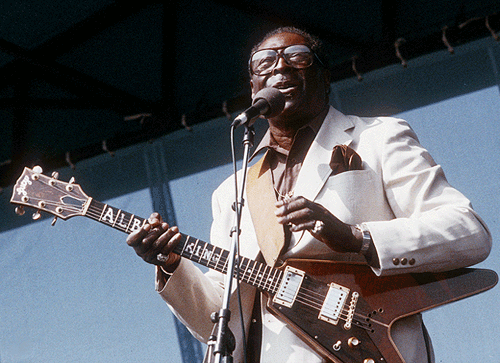 |
| Albert King, 1988. Photo by Randy Jennings. |
Rick: Yeah, on occasion we’ll complete a photo release form. But, usually it’s like you said, it’s the first three songs, no flash. Basically get in do your job and get out, even though the whole crowd seems to be taking flash photos with their phones.
Randy: Well, you know the thing is, I was starting to do stuff with Metal Edge and some of the metal magazines back in the ’90s. They all wanted flash and I told them, “You can’t do that!” You’ll get hit with flashlights if you shoot flash!
Rick: Those big biker boys will come around.
Randy: Yeah, there was somebody who cracked me on the upper arm with one of those three cell Mag Lites! And it hurt! He said, “No flash! Who are you shooting for?” And I can’t remember if it was Metal Edge or not, but I remember, “No flash!”
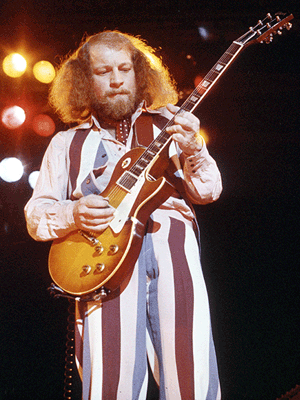 |
| Martin Barre, 1977. Photo by Randy Jennings. |
Rick: Have you done any videography?
Randy: I did a minimal amount of videography in college. It was back in the mid ’80s, when I was really wrapped up in music. It was kind of a rushed project. I did a music video of Lonnie Mack’s “Oreo Cookie Blues” It was a steamy little thing with a blonde from one of my classes. The only public airings were in class. I also showed it to Lonnie, his wife, road manager and Jon Paris from the Johnny Winter band. Lonnie was amused and wanted to see it again.
Rick: What young rock musicians do you find particularly worthy of coverage or who do you like that you’d like to cover?
Randy: I pondered on that question about “young.” Even Kenny Wayne Shepherd is 30 now. But, John Mayer, I would really like to shoot John Mayer. I knew he was a singer and songwriter. But, then I heard Try with Tino Palladino and Steve Jordan. Mayer’s voice even reminds me of Stevie Ray Vaughan. It’s kind of like you pick up sounds of Hendrix and Stevie and Clapton. It’s phenomenal. I really like the three piece, like Kenny Wayne Shepherd. Let’s see, I didn’t shoot Jonny Lang. But, I did see him. Derek Trucks is someone who I’d like to work with. I’ve seen him and he’s just phenomenal.
There again, some of the other people aren’t that young, like Warren Haynes. I shot him with the Allman Brothers. And I like female artists like Susan Tedeschi .
Somebody I photographed back in 1990 was Michelle Malone, I hadn’t really heard much about her and then I saw a disc of hers called Sugarfoot. She’s really a gifted artist. I don’t want to say I was amazed. But, it was so much different than what I initially heard back in 1990. She seems to be taking more of a blues route now, which seems to be where my heart always falls back to, blues and blues rock.
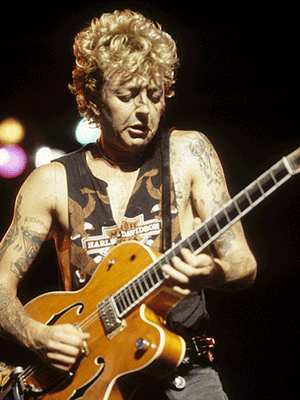 |
| Brian Setzer, 1989. Photo by Randy Jennings. |
Rick:People are sometimes called photogenic and that doesn’t always mean that they’re good looking and attractive in the conventional sense. How would you define the term and who in your opinion in fits that perspective?
Randy: Well, there are certain people that I’ve shot like Robert Plant back in the ’70s. The poses. And, of course, Rod Stewart back in the ’70s and Albert Collins.
I have to go back to Collins, because that man, he had so much character in his facial expressions. It’s just phenomenal. You never knew what he was going to do. Sometimes he’d open his eyes real wide, Sometimes he’d squint them. I’ve got this one where his eyes are just closed and it’s such a mood shot. And, of course, it’s black and white.
With some blues singers, you really see the blues in their face, like Albert Collins, Albert King and Coco Taylor. It’s just there. There’s only been one or two times that I’d get something and I really didn’t feel like I caught something. In at least a couple of shots I always feel like I’ve captured the person. Especially back in the day.
And nowadays, that’s what I don’t like about the first three songs limit. Clapton may not become Clapton until half way into the show. You know what I mean? It’s there where they’re getting warmed up and not feeling it yet. And I may not be feeling it yet. That’s where I really feel the drawback of the first three songs. But, back to the question. Albert Collins, Robert Plant, Coco Taylor, Stevie Ray Vaughan. It’s the feel and more of an emotion than a visualization with me.
Rick: I understand that you’ve done some album covers. How do you approach the illustrative concept?
Randy: Well, the Lonnie Mack thing, that was something that was just selected after the fact. I did go shoot another cover for Lonnie that we didn’t discuss. But, I just kind of drove down when he was living in Indiana, before he moved to Nashville, and we went to a bar and he walked in and he said, “Well, I’m here to do another album. Just take as much time as you want.”
I just shot the stuff and it wasn’t exactly what Alligator was looking for. Lonnie liked it and Carol liked it. But, it was just a matter of creative difference. Most of the things I’m doing are local so we’ll have a brainstorming session. I’d want to have a concept, even if it’s not a CD cover. Even if it’s just for a promo. I like to have a concept. I may throw my idea completely out, because something comes to me during the shoot. I’m not a clock watcher. I show up and I hate to use the term fly by the seat of my pants. But, I’m not so rigid that I can’t stray away from my original concept.
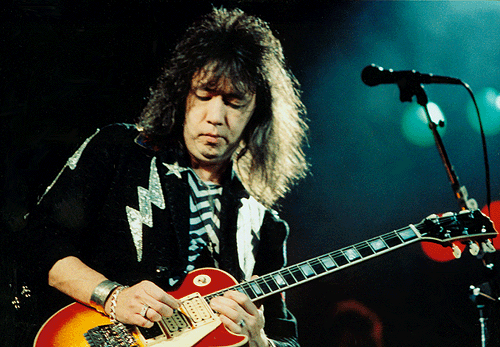 |
| Ace Frehley, 1987. Photo by Randy Jennings. |
Rick: Over the years there have been a number of great album covers issued. Can you name your top five favorites?
Randy: This is very challenging, because I didn’t really pull albums out and look at them. But, off the of my head, I love The Doors Greatest Hits, the Joel Brodsky photo session with Morrison. You know, the black and white ones, the shirtless ones. the Muddy Waters Live, the Muddy Mississippi Waters, the Blue Sky release that Johnny Winter produced.
There again it’s black and white. I love that style; without realizing that I was emulating that somewhat because it’s the shallow depth of field and the out of focus head on the guitar. But, as it gradually comes down the neck it comes into focus and there’s Muddy’s face. It’s the point of focus and then his right arm’s going out of focus. That’s where I see a lot of my stuff, like Lonnie Mack and Dickie Betts.
If you’re shooting for Fender or Gibson, they’re going to want to see the guitar in focus. I love things that are out of focus, as long as the person is in focus, like the Muddy Water’s one. I love The Stones Love Ya Live, because of the Andy Warhol concept with the Polaroid’s and his silk screening. The concept was kind of a fun album and kind of camp.
I like the album of Dickie Betts and Great Southern, I don’t want to call it his debut, but with the Great Southern debut in ’77. I believe the cover has a Georgia plantation on it. The front was kind of cool and grainy, kind of surrealistic looking. The back cover was a sepia portrait of the band. It was a nice concept. Also, I’d say the two Johnny Winter live albums, Johnny Winter and Live.
I like that one, and then Capture Live which was kind of ironic cause it coincided with my first concept, hence part of the name of my photography business, Captured Live. Oh, and the Fillmore with the Allman Brothers album. I think a lot of it is the stories behind the covers. You’ve heard the Fillmore story with Jim Marshall and why they’re all laughing?
Rick: No, I haven’t heard the story.
Randy: Oh, well I guess off the record, well, it’s in his book. Nobody wanted to smile or whatever and he says, “Nobody gets anymore coke until you smile.” So, everybody starts laughing and he snaps the picture. Oh, and the Henry Diltz photo of the Morrison Hotel, you heard about that one?
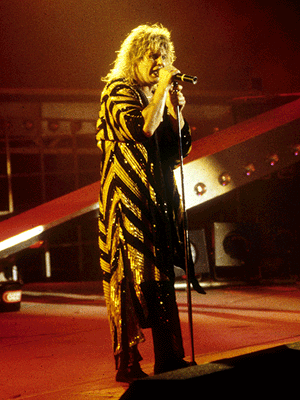 |
| Ozzy Osbourne. Photo by Randy Jennings. |
Rick: Yeah, I met Henry a couple of years ago in L.A.
Randy: A friend of mine knows Henry and he was in Dayton here not too long ago. I said, “You had Henry Diltz at your house and you didn’t call me to come over? Don’t ever do that again!.”
But, what happened was they went into Morrison’s Hotel that was in a Skid Row hotel, and they asked the desk clerk if they could come in and shoot some pictures. The guy said, “No!” So, they just kind of hang out and watch the guy and he goes upstairs and disappears somewhere. Jim Morrison and the group ran in real quick and Henry just rips off a couple of shots and they leave.
Henry has a DVD out called Under the Covers and there’s a lot of interesting information in that. It’s well worth the watch.
Rick: I’ll do that. When I met him he was a real nice guy. I was with another superb rock photographer, Robert Knight. Heard of him?
Randy: Oh, yeah.
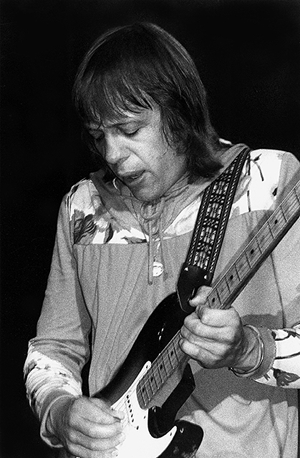 |
| Robin Trower. Photo by Randy Jennings. |
Rick: Do you ever go to a gig without a camera or are you always prepared, do you always bring one with you?
Randy: Rarely. If I’m going to go, I’m going to shoot. I don’t go just for entertainment a whole lot. I was watching a show called Love Monkey and saw this really young kid Teddy Geiger, a talented songwriter. We went to see him and we were in the fifth row and it was just screaming teenage girls, and I was like,”God, I’m almost 50 years old. I can’t believe I’m doing this.” But, I get antsy, and I don’t want to say bored. I get uncomfortable when I’m not shooting. I feel like I should be shooting.
I did get to see Rick Derringer a while back without a camera. I hadn’t seen him since 1975. And I had a picture and I got it signed. He looked at it and put his hand up over his head, like, “Oh, my God!” He’s changed a lot since ’75.
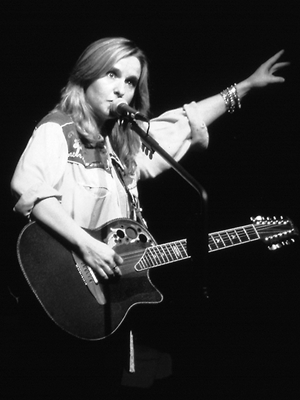 |
| Melissa Etheridge, 1994. Photo by Randy Jennings. |
Rick: Do you use the golden rectangle as a conceptual construct?
Randy: When you first start shooting you just go in and hope you got something on film. Nowadays, I try not to let the technique and the training dictate what I do, because I’ll spend too much time calculating and planning a shot than shooting.
But, I do still try to keep in mind stuff. I used to stick the head right in the middle of the frame years ago. But, now I look at stuff without a camera, as if I have a camera. It’s almost like the way I view life, through a lens.
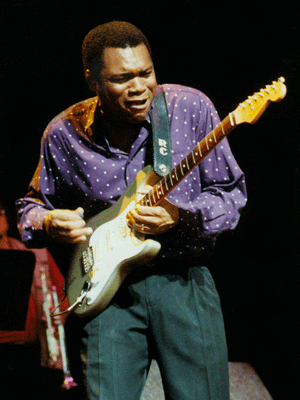 |
| Robert Cray. Photo by Randy Jennings. |
Rick: Your work extends beyond rock performance. Have you gathered ideas or approaches from those other arenas of photography and migrated them to make you a better performance oriented photographer?
Randy: Oh, yeah! I did some newspaper work and I don’t know if the rock helped the sports photography or the sports helped the rock photography. It’s about timing and anticipation of what’s going to happen. And all of them, whether the glamour, nature, or rock ‘n’ roll photography, it’s all about light.
You can wait nature out for the right lighting. In glamour, I get into trouble when I think I can control something like the lighting. I’m at the venue or the light guy’s mercy. If I know that I have no control over what’s going on, all I can do is use the setting or change vantage points. That helps too. It’s one variable that I don’t have to worry about, because I can’t do anything about it. I just have to accept what’s going on around me.
It’s when I think I can change something around me to make it better, like changing lighting. I’m one of those people who’d rather shoot environmentally than in the studio. I’ve got the toys and trinkets and stuff. But, the more I have the more I am fiddling with them. I don’t like to nail stuff down and say, “Okay, this is tried and true. This is how I’m gonna do it.”
I like to move it around and change it about. Like I said, it’s all about light and the anticipation of movement. You have to be quick with the sports. I did music first and then I did newspaper sports. I think it carries back in to anticipation and steady camera movements, following your subject and stuff like that with music.
Rick: Let’s end this with the number of rock musicians that you’ve covered. Let’s start at the bottom of that list, and one of my favorites, Warren Zevon. Now what was that shoot like?
Randy: It was in Cincinnati. As far as making the arrangement, it was smooth. I believe he was still with the Giant label supporting Learning to Flinch.
Actually, the first track was recorded at that venue, Bogart’s in Cincinnati. I really didn’t know that it was gonna be just a solo show. He played guitar and then he played the piano. It was a really intimate show. I feel very fortunate that it was the one and only time I got to see him. I didn’t meet him afterward. There was a little mix up with the club owner and the road manager over my arrangements. That was kind of an awkward thing. I was supposed to be there. But, he didn’t have passes actually printed and you couldn’t bring a camera in, unless you had a photo pass. Warren’s road manager says, “He’s our photographer,” and the owner says, “He can’t come in without a pass.” I’m sure you’ve been through that.
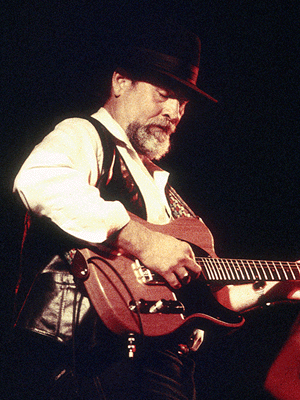 |
| Roy Buchanan. Photo by Randy Jennings. |
Rick: Rarely, but it can happen.
Randy: It’s annoying, but it’s only rock and roll.
Rick: Jimmy Page?
Randy: Jimmy Page was back in the day. You’d just show up and shoot. No arrangements, no passes, nobody cared. It was the Midwest here and nobody seemed to think much about it. Like I said, I would take in two full bags and shoot the entire show! There was no photo pit. You just went and wherever you could get you could shoot.
Rick: Clapton?
Randy: Shooting Clapton has always been a pleasure. A real treat. One of music’s all time greatest. It’s never a problem with the “three songs and out” rule. His first three songs usually gave me about 20 minutes of shooting. It amazes me how the man can maintain the level of humility he does with all of his outstanding accomplishments throughout his life and career. He is legendary among his peers, young and old.
Rick: What have been your most recent projects?
Randy: Since our first discussion for this interview, I’ve been transitioning from film to digital. Up until now, my cameras didn’t require batteries for me to shoot. So, with all of the new buzzers, bells and whistles on my digital, I have been getting acclimated to it by shooting some local club acts, to get my chops up to speed.
This summer I have had the privilege of having photos in Craig Hopkins’ Stevie Ray Vaughan – Day After Day, Night After Night book. In addition, I have supplied photos for a SRV die cast guitar replica from GMP Diecast. Photos have been used for packaging and advertisements. This project happened very quickly. It’s licensed by both Fender Guitars and the Vaughan Family Estate.
Related Links
Captured Live Photography
2-Artists
SRV Die Cast Guitar
Robert Knight – Behind the Lens
Richard Aaron – Behind the Lens
Michael G. Stewart – Behind the Lens
Gene Martin – Behind the Lens
Maryanne Bilham – Behind the Lens
W.A. Williams – Behind the Lens